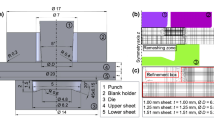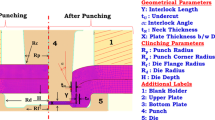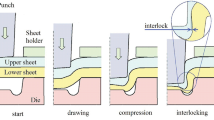Abstract
Conventionally, the mechanical strength of clinched connections is determined by a single shear lap test and/or a pull-out test. However, in most practical applications a combination of shear and pull-out is exerted on the clinched joint. This paper deals with the development of an Arcan-like device which enables to introduce various shear/tensile ratios in a clinched assembly. An experimental survey of the multi-axial behaviour of a non-cutting single-stroke round clinched connection of two DC05 sheets, which is mild deep drawing steel, is conducted with this modified Arcan setup. These experimental results are used to check the validity of numerical models that predict the strength under multi-axial loading. Since the forming of a clinch is a fairly complex sheet metal operation, a good knowledge of the plastic material properties and the frictional behaviour is of the utmost importance to perform a sufficiently accurate FEA simulation. The impact of these factors on the multi-axial loading behaviour of the DC05–DC05 connection is investigated.




















Similar content being viewed by others
References
Nong N, Ouyang K, Zhang Y, Qiao Z, Tao C, Li F (2003) Research on press joining technology for automotive metallic sheets. J Mater Process Technol 137:159–163
Neugebauer R, Kraus C, Dietrich S (2008) Advances in mechanical joining of magnesium. CIRP Ann Manuf Technol 57:283–286
Pirondi A, Moroni F (2011) Science of clinch-adhesive joints. Adv Struct Mater 6:109–147
Sadowski T, Balawender T (2011) Technology of clinch-adhesive joints. Adv Struct Mater 6:149–176
Hamel V, Roelandt JM, Gacel JN, Schmit F (2000) Finite element modeling of clinch forming with automatic remeshing. Comput Struct 77:185–200
de Paula AA, Aguilar MTP, Pertence AEM, Cetlin PR (2007) Finite element simulations of the clinch joining of metallic sheets. J Mater Process Technol 182:352–357
Coppieters S, Cooreman S, Lava P, Sol H, Van Houtte P, Debruyne D (2010) Reproducing the experimental pull-out and shear strength of clinched sheet metal connections using FEA. Int J Mater Form. doi:10.1007/s12289-010-1023-6
Oudjene M, Ben-Ayed L, Delamézière A, Batoz J.-L. (2008) Shape optimization of clinching tools using the response surface methodology with moving least-square approximation. J Mater Process Technol 209:289–296
Saberi S, Enzinger N, Vallant R, Cerjak H, Hinterdorfer J, Rauch R (2008) Influence of plastic anisotropy on the mechanical behaviour of clinched joint of different coated thin steel. Int J Mater Form Suppl 1:273–276
Joma M, Billardon R (2007) Numerical analysis of the resistance to pullout test of clinched assemblies of thin metal sheets. In: Proceedings of the 10th ESAFORM conference, pp 169–174
Langrand B, Combescure A (2004) Non-linear and failure behaviour of spotwelds: a “global” finite element and experiments in pure and mixed modes I/II. Int J Solids Struct 41:6631–6646
Langrand B, Patronelli L, Deletombe E, Markiewicz E, Drazétic P (2002) An alternative numerical approach for full scale characterisation for riveted joint design. Aerosp Sci Technol 6:343–354
Arcan M, Hashin Z, Voloshin A (1978) A method to produce uniform plane-stress with applications to fiber-reinforced materials. Exp Mech 35:141–146
Sutton MA, Boone ML, Ma F, Helm JD (2000) A combined modeling-experimental study of the crack opening displacment fracture criterion for characterization of stable crack growth under mixed mode I/II loading in thin sheet metals. Eng Fract Mech 66:171–185
Kavamura HA, Batalha GF (2008) Mechanical strength evaluation for Nd-YAG laser and electric resistance spot weld (ERSW) joint under multi-axial loading. J Mater Process Technol 201:507–514
Patronelli L, Langrand B, Deletombe F, Markiewicz E, Drazétic P (1999) Analysis of riveted joint failure under mixed mode loading. Eur J Mech Environ Eng 44:223–228
Porcaro R, Hanssen AG, Langeth M, Aalberg A (2006) The behaviour of a self-piercing riveted connection under quasi-static loading conditions. Int J Solids Struct 43:5110–5131
Greer JM, Galyon Dorman SE, Hammond MJ (2011) Some comments on the Arcan mixed-mode (I/II) test specimen. Eng Fract Mech 75:2088–2094
Merklein, M, Gödel, V (2009) Characterization of the flow behaviour of deep drawing steel grades in dependency of the stress state and its impact on FEA. Int J Mater Form Suppl 2:415–418
Maeda, Y, Yanagawa, M, Barlat, F, Chung, K, Hayashida, Y, Hattori, S, Matsui, K, Brem, JC, Lege, DJ, Murtha, SJ and Ishikawa, T (1998) Experimental analysis of aluminum yield surface for binary Al-Mg alloy sheet samples. Int J Plasticity 14(4–5):301–318
Kajberg, J, Lindkvist, G (2004) Characterisation of materials subjected to large strains by inverse modelling based on in-plane displacement fields. Int J Solids Struct 41:3439–3459
Rossi, M, Pierron, F (2012) Identification of plastic constitutive parameters at large deformations from three dimensional displacement fields. Comput Mech 49:2492–2497
Coppieters S, Lava P, Sol H, Van Bael A, Van Houtte P, Debruyne D (2010) Determination of the flow stress and contact friction of sheet metal in a multi-layered upsetting test. J Mater Process Technol 210:1290–1296
Coppieters S, Cooreman S, Sol H, Van Houtte P, Debruyne D (2011) Identification of the post-necking hardening behaviour of sheet metal by comparison of the internal and external work in the necking zone. J Mater Process Technol 211:545–552
Totten GE, Funatani K, **e L (2004) Handbook of metallurgical process design. Marcel Dekker, Inc. New York
Coppieters S, Lava P, Sol H, Van Houtte P, Debruyne D (2011) Identification of post-necking hardening behaviour of sheet metal: a practical application to clinch forming. Key Eng Mater 473:251–258
Joma M, (2007) Simulation numerique des procedes de clinchage et de rivetage pour application automobile. PhD thesis, Université Pierre et Marie Curie, France
Mucha J, (2011) The analysis of lock forming mechanism in the clinching joint. Mater Design 32:4949–4954
Author information
Authors and Affiliations
Corresponding author
Rights and permissions
About this article
Cite this article
Coppieters, S., Lava, P., Hecke, R.V. et al. Numerical and experimental study of the multi-axial quasi-static strength of clinched connections. Int J Mater Form 6, 437–451 (2013). https://doi.org/10.1007/s12289-012-1097-4
Received:
Accepted:
Published:
Issue Date:
DOI: https://doi.org/10.1007/s12289-012-1097-4




